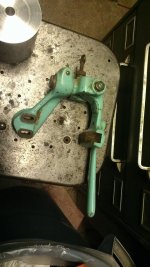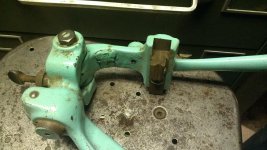Professor:
I can;t resist throwing this in: Re: Triumph TR 3.... I thought the "Prince of Darkness" (Lucas) had provided electrics for the Triumph cars and motorcycles, and implanted electrical gremlins. That being the case, it would account for excessive wear on the starter commutator, endless grinding away trying to get the car started. When I was in engineering school (1968-72), some of my classmates had Triumphs, MG's, and a lone Austin Healey. All of them had electrical problems on a continual basis. To get in any of those cars and get them started without a struggle was the exception. I rode Triumph and Norton motorcycles, which were a shade better. That was 40 years ago.
Recently, a friend was given some basket case British bikes from the 50's. He chose to reassemble a Triumph "Thunderbird" motorcycle, his first time around British bikes and British electrics. It had the old Lucas magneto for ignition and Lucas "dynamo" to charge the battery for lighting. I told him to sell the remains of the Lucas magneto and dynamo, and put in a Joe Hunt magneto, and to go to an alternator retrofit for the lighting/charging system. I told him about the Prince of Darkness and told him if he wanted to ride that old Triumph, he'd do well to s--tcan the Lucas electrics. He did just that and has a Triumph that starts on the first or 2nd kick.
As for my college classmate with the Austin-Healey, he got pretty disgusted with it in short order. Parts, even in 1969, were hard to come by. The electrics were forever leaving him stranded or looking for someone to give it a jump start. Push starting on city streets rarely worked. The A-H owner finally got so fed up that he bought the engine, tranny, and driveshaft out of a wrecked Volvo sport model ( P 1800, IIRC). He ripped the A-H engine and tranny out of the A-H, and cobbed in the Volvo engine and tranny, salvaging the driveshaft front yoke/U joint and making up a "compromise" driveshaft to use the A-H rear end. Once he got the Bosch electrics in that A-H, it was like night and day. The thing started reliably and never left him stranded again.
Another guy in engineering school decided he wanted to own an E type Jaguar. He found one within his price range, so it had some years and miles on it and had "issues". Being a typical mechanical engineering student of that era, he figured he could get things straightened out and have a good Jag. Wrong. Endless trips to the foreign car junker and endless trips to imported car parts places and going bankrupt was what that Jag did for him. He had bought it thinking he'd have what, today, is called a "chick magnet" aside from a fast, well handling sports car. He had anything but. He finally got so mad at that Jaguar that he ripped out the Jag's engine and tranny and cobbed in a small block Chevy V-8 and four speed tranny. It was a cob job with a lot of wires dangling and some interesting fabrication for the accelerator linkage and motor mounts and tranny mounting, but it worked. This was back when MIG welding was just coming on the scene, so for light/thin metal fabrication the options were limited. It was stick welding and oxyacetylene welding or brazing, and it was also a case of whatever materials could be begged, borrowed or stolen. But, with the small block Chevy engine and tranny, the Jag was suddenly a reliable and easy to maintain car.
We used to joke that the reason the British drank their beer warm was because the Prince of Darkness had provided the refrigerators and wiring. In the late 60's and early to mid 70's, people around me who owned British cars seemed to spend a disproportionate amount of time either trying to get them started or fixing them. We were young and crazy back then, and working on next to no budget and using junkyard parts and whatever else we could come up with was the norm. I think today's young people are missing a great learning experience as cars are absolutely bland and generally quite reliable, if not impossible for the average owner to repair or work on.
BTW: When I turn a commutator, I use a sharp "vee" toolbit much like a threading toolbit. I stone the nose to the slightest radius and stone the cutting edge to make sure they are absolutely sharp. As you noted, I take very light cuts. If you look at how an armature is made, the commutator bars are held in place by "banding". This is sometimes twine wound under tension, tied off and varnished with insulating varnish. Sometimes, a thin collar made of insulating material is driven over the ends of the commutator. Either way, not too much is holding the commutator bars in place. They have to be insulated from each other and from the shaft. If a toolbit takes too deep a cut or digs in, it can loosen or peel the commutator bars off.
I set my toolbit exactly on center, and make sure it is freshly stoned anytime I touch up a commutator.






